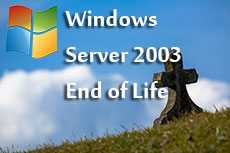One of Microsoft’s most popular products will essentially be scrapped this summer, leaving millions to find suitable replacements. So how should you be dealing with the winding down of Windows Server 2003?
The name ‘Microsoft’ is synonymous with enterprise IT. The Washington tech company’s products have fuelled businesses across the globe for decades now, and with the firm’s future looking brighter than ever, there’s clearly a lot more to come. At present, though, most Microsoft-related conversations revolve around Windows Server 2003, and for good reason.
In the middle of July – the 14th to be precise – the seemingly omnipresent server operating system will officially enter end-of-life status. This means users will stop receiving security updates, and technical support will no longer be provided. Those who fail to act will be left more vulnerable than ever to data breaches, and the consequences could potentially be devastating.
Here are a few tips to help you through the transition:
Act quickly
There’s still time to avoid such problems, but you’ll need to get the ball rolling soon. It’s now less than 100 days until the switch-off date, and while this might seem like ages, there’s still plenty of work to do. Of course, the actual timeframe will depend on a number of factors, like company size and your own level of reliance on the OS. According to David Mayer of US tech firm Insight, a customer with 100 or more servers could be looking at a project that lasts anywhere between three and 18 months.
Analyse and prioritise
For those that won’t quite make the deadline comfortably – and even those that will – it’s worth analysing the workload in detail so you can prioritise exactly what needs to be done. Segregate the server environment into categories based on how critical they are to the business, and their current vulnerability. You’ll want things separated into high-risk, medium-risk and low-risk. Then focus on the top and work down.
Choose carefully
When it comes to choosing your next step, you have a couple of options. Assuming you’ve accepted that doing nothing is a bad idea, you can either move to one of the next available Microsoft platforms (Windows Server 2008/2012) or adopt more of a cloud-driven approach.
The first option might be appealing for a couple of reasons. For one, you’re staying in familiar territory and will instantly regain the highly valuable support of the technical team at Microsoft. Be aware, though, that you’ll likely be in exactly the same end-of-life situation in five or ten years’ time. On the other hand, the cloud offers plenty for the forward-thinking, modern enterprise. Pick the right solutions and you’ll benefit from more cost-efficiency, scalability and plenty of exciting new opportunities.
Are you facing this decision? We can help!
We offer a FREE 2 hour IT review.
Simply fill out the form below and one of our engineers will happily arrange an appointment.
Error: Contact form not found.




